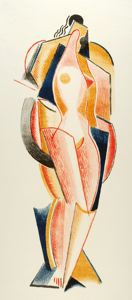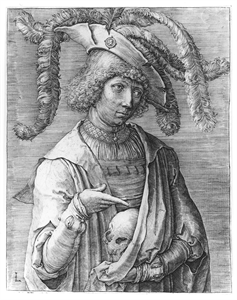
Alexander Archipenko
American, born Ukraine, 1887–1964
From the portfolio, Alexandre Archipenko: Dreizehn Steinzeichnungen
Innovative artist Alexander Archipenko (American, born Ukraine, 1887–1964) was a seminal figure in early twentieth-century art, renowned for his achievements in modern sculpture. Archipenko found inspiration in the works of Cubists and Italian Futurists, forging new ground by combining traditional and nontraditional materials. His signature "sculpto-paintings," a fusion of both painting and sculpture, and his technique of incorporating voids within his works proved his pioneering, avant-garde approach. Archipenko also embraced printmaking and he worked in a variety of print techniques. Prints were often studies for his three-dimensional pieces or refinements of his completed sculptures. This is often how Archipenko worked. He returned to earlier ideas and created a symbiotic relationship between his drawings, prints, and sculptural works. As he explored his ideas in one medium it would spur ideas for exploration in another format. In 1921, Archipenko created the portfolio, "Alexandre Archipenko: Dreizehn Steinzeichnungen" (translated as thirteen stone carvings, or thirteen lithographs) with the publisher Verlag Ernst Wasmuth in Berlin. This grouping of thirteen prints includes Archipenko’s first foray with color in the graphic arts. In addition to other subjects, a number of sheets in the portfolio feature the female nude, an image that, rendered abstractly or realistically, was the touchstone that Archipenko returned to throughout his career. Of the thirteen images in this portfolio, at least six have a direct correlation to either drawings or sculptures demonstrating the range of his concerns, from the female nude to Cubism. For example, "Standing Woman" resembles several of Archipenko's constructions and sculpto-paintings, particularly "Woman," 1923. Regarding this piece, Karshan comments on how it was "Unusual at that time for artists to employ such bright colors in lithographs of cubist design." (1)
(1) Donald Karshan, Archipenko: The Sculpture and Graphic Art, Including a Print Catalogue Raisonné, Tübingen: Ernst Wasmuth, 1974, p. 95.
American, born Ukraine, 1887–1964
Untitled (Standing Woman)
1921From the portfolio, Alexandre Archipenko: Dreizehn Steinzeichnungen
Object Type:
Print
Dimensions:
16 5/8 in. x 6 in. (42.23 cm x 15.24 cm)
Medium and Support:
Color lithograph on paper
Accession Number:
2007.0003.0009
Credit Line:
Montgomery Museum of Fine Arts Association Purchase and Gift of Margaret Lynne Ausfeld in memory of Adolph "Bucks" Weil, Jr.
Copyright:
© Estate of Alexander Archipenko / Artists Rights Society, (ARS), New York
Innovative artist Alexander Archipenko (American, born Ukraine, 1887–1964) was a seminal figure in early twentieth-century art, renowned for his achievements in modern sculpture. Archipenko found inspiration in the works of Cubists and Italian Futurists, forging new ground by combining traditional and nontraditional materials. His signature "sculpto-paintings," a fusion of both painting and sculpture, and his technique of incorporating voids within his works proved his pioneering, avant-garde approach. Archipenko also embraced printmaking and he worked in a variety of print techniques. Prints were often studies for his three-dimensional pieces or refinements of his completed sculptures. This is often how Archipenko worked. He returned to earlier ideas and created a symbiotic relationship between his drawings, prints, and sculptural works. As he explored his ideas in one medium it would spur ideas for exploration in another format. In 1921, Archipenko created the portfolio, "Alexandre Archipenko: Dreizehn Steinzeichnungen" (translated as thirteen stone carvings, or thirteen lithographs) with the publisher Verlag Ernst Wasmuth in Berlin. This grouping of thirteen prints includes Archipenko’s first foray with color in the graphic arts. In addition to other subjects, a number of sheets in the portfolio feature the female nude, an image that, rendered abstractly or realistically, was the touchstone that Archipenko returned to throughout his career. Of the thirteen images in this portfolio, at least six have a direct correlation to either drawings or sculptures demonstrating the range of his concerns, from the female nude to Cubism. For example, "Standing Woman" resembles several of Archipenko's constructions and sculpto-paintings, particularly "Woman," 1923. Regarding this piece, Karshan comments on how it was "Unusual at that time for artists to employ such bright colors in lithographs of cubist design." (1)
(1) Donald Karshan, Archipenko: The Sculpture and Graphic Art, Including a Print Catalogue Raisonné, Tübingen: Ernst Wasmuth, 1974, p. 95.
Keywords
Click a term to view the records with the same keyword
Related Objects
Click a record to view

Title Page
2007.0003.0001

Untitled (Construction)
2007.0003.0002

Untitled (Still Life with Vase)
2007.0003.0003

Untitled (Still Life)
2007.0003.0004

Untitled (Two Standing Figures)
2007.0003.0005

Untitled (Two Figures)
2007.0003.0006

Untitled (Bather)
2007.0003.0007

Untitled (Three Female Figures)
2007.0003.0008

Untitled (Figure Study)
2007.0003.0010

Untitled (Laokoon)
2007.0003.0011

Untitled (Two Women)
2007.0003.0012

Untitled (Two Bending Figures)
2007.0003.0013

Untitled (Two Women, One Seated)
2007.0003.0014
Portfolio List
Click a portfolio name to view all the objects in that portfolio
This object is a member of the following portfolios:
Your current search criteria is: All Object records.

 by Artist (743)
by Artist (743)
